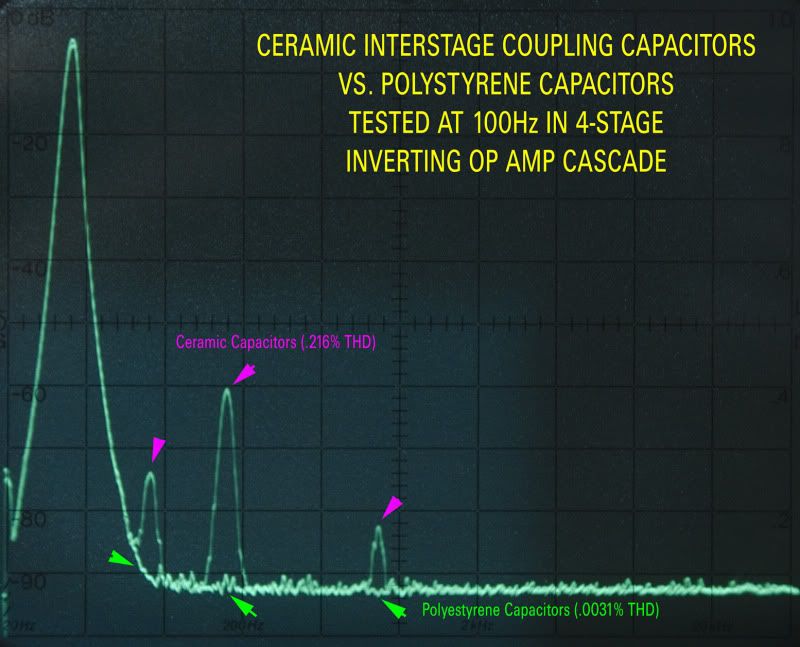This is some very interesting results that I obtained while testing capacitors in interstage op-amp circuits.
I breadboarded a quad of inverting op-amp stages and intercoupled them with capacitors for this experiment.
The first trace with the green callouts is four polystyrene capacitors intercoupling. The second is four ceramic disc caps in place of the poly caps. No other changes. I performed this test yesterday at 1KHz and found small differences that only my Tektronix AA501 Distortion Analyzer could detect reliably, but today I used 100Hz as the test frequency and the differences amplified 100-fold.
The ceramic caps produced .216% THD while the poly caps produced .0031% THD at 100Hz.
I also did testing at 10Hz and this produced enough distortion that I could see it on an oscilloscope and see what exactly was happening. The waveform with the ceramic cap became almost triangular with a notch at zero crossing. The poly produced a clean sine wave.
Here's a superimposed snapshot of the 100Hz spectrum analysis. It proves that I was not measuring noise, but actual harmonics. Note that the ceramic has a dominant THIRD harmonic here:

http://i16.photobucket.com/albums/b28/mweiss/CeramicvsPoly100Hz.jpg
So this tends to suggest that the grade of interstage coupling capacitors used in audio amplifiers, particularly at bass frequencies, is rather important.
I breadboarded a quad of inverting op-amp stages and intercoupled them with capacitors for this experiment.
The first trace with the green callouts is four polystyrene capacitors intercoupling. The second is four ceramic disc caps in place of the poly caps. No other changes. I performed this test yesterday at 1KHz and found small differences that only my Tektronix AA501 Distortion Analyzer could detect reliably, but today I used 100Hz as the test frequency and the differences amplified 100-fold.
The ceramic caps produced .216% THD while the poly caps produced .0031% THD at 100Hz.
I also did testing at 10Hz and this produced enough distortion that I could see it on an oscilloscope and see what exactly was happening. The waveform with the ceramic cap became almost triangular with a notch at zero crossing. The poly produced a clean sine wave.
Here's a superimposed snapshot of the 100Hz spectrum analysis. It proves that I was not measuring noise, but actual harmonics. Note that the ceramic has a dominant THIRD harmonic here:

http://i16.photobucket.com/albums/b28/mweiss/CeramicvsPoly100Hz.jpg
So this tends to suggest that the grade of interstage coupling capacitors used in audio amplifiers, particularly at bass frequencies, is rather important.
















